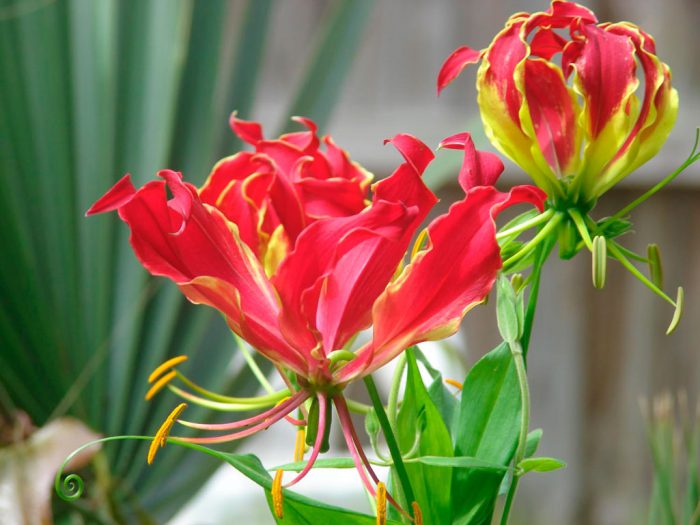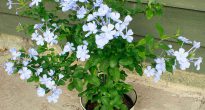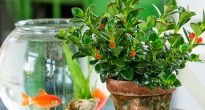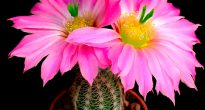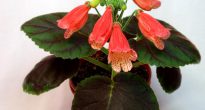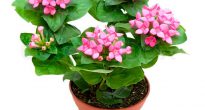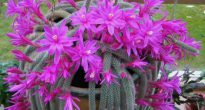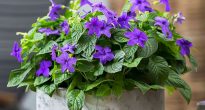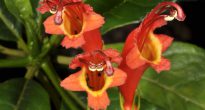In nature, a plant like gloriosa (Gloriosa) is found in tropical regions of Africa and Asia. This genus is a member of the melantia family and unites from 5 to 9 species of various plants. Initially, this genus was attributed to the lily family.
This plant has a very showy appearance. The name gloriosa comes from the Latin word Gloria, which means "glory."
Gloriosa is a herbaceous tuberous perennial. Curly stems are covered with many leaves. Sessile, elongated-lanceolate leaves are arranged oppositely or in 3 pieces. Long peduncles emerge from the leaf axils at the tops of the plants, on which beautiful flowers grow.
Gloriosa care at home
Illumination
The plant needs bright, but diffused lighting. It feels best on the windows of either western or eastern orientation. If placed on a south-facing window, then it will be necessary to shade from direct sunlight. A newly purchased plant is gradually accustomed to bright lighting. The same is done after rather long cloudy weather.
Temperature regime
In the spring and summer, the flower requires an air temperature of 20 to 25 degrees. It should be protected from cold air masses and drafts, since gloriosa reacts to them extremely negatively. In winter, there is a dormant period. After the end of flowering (in the autumn), it is necessary to gradually reduce watering, and then completely stop. At the beginning or middle of the autumn period, the part of the plant that is above the ground dies off. The tubers should be removed from the soil, sprinkled with a little dry sand and placed in a cool place (8-10 degrees) for storage. They should be there until landing.
How to water
In the spring-summer period, watering should be abundant and for this use soft, well-settled water. Make sure that the soil in the pot is always slightly damp. Watering is not done in winter.
Air humidity
When grown at home, high humidity is required. It is recommended to pour a little pebbles or expanded clay into the pallet and pour in water, however, the bottom of the pot should not come into contact with the liquid.It is necessary to carry out daily spraying, however, make sure that the liquid does not fall on the surface of the flowers, as this may result in specks, which will cause the plant to lose its decorative effect.
Flowering features
The bloom is incredibly beautiful and is observed during the summer. The flower itself tilts, and the perianth rises, and this not only looks very impressive, but also attracts insects. Pollination is believed to be due to the fact that butterflies are unable to land on the flower. They drink nectar on the fly, while waving their wings, and this leads to the fact that the anthers sway and the pollen gets on the stigma. Gradually, the yellow color changes to red, while the flowers bloom in turn (about 7 inflorescences in one season).
Fertilizer
After the plant gets stronger in spring, you need to start feeding with a special liquid fertilizer for indoor plants. Top dressing is carried out during the entire flowering period, while the instructions must be followed.
Support
Since this plant is a liana, it needs a support for which it will hold on with antennae located at the tips of the leaves. The shoots themselves are rather fragile, and in order to avoid their fractures due to the absence of antennae in the lower part, it is recommended to tie them up. Shoots cannot grow around the support, they are attached with antennae to something thin. In the case when it is impossible to place a thin support such as a wire, the shoots must be tied up regularly. From May to June, intensive growth is observed, and during this time the plant can reach a height of 200 centimeters, but this is undesirable. To shorten the length, you should carefully direct the shoots down, while bending them slightly.
Transplant features
The transplant is carried out once a year in the spring. At the same time, it is recommended to choose a capacity of ceramic, low and wide. To prepare the soil mixture, it is necessary to combine humus and deciduous soil, peat and sand in a concentration of 4: 2: 0.5: 0.5. Don't forget a good drainage layer. When planting, the tuber is placed horizontally, while it is covered with earth only 2 centimeters. It should be noted that the tuber has a single bud and if it is lost, the sprout will not appear (part of the tuber is not suitable for planting). Planting is carried out at the end of the winter beginning of the spring period, while the land must be constantly slightly moistened and a temperature of 15–20 degrees is required. When the stems appear, the container is rearranged on a well-lit windowsill.
Reproduction methods
You can propagate by tubers or seeds.
Most often propagated by tubers. For planting, pots with a diameter of 13 centimeters are used, filled with an earth mixture consisting of leaf, humus and sod land, as well as sand, which must be taken in a ratio of 2: 2: 1: 0.5. The tuber is sprouted up (this is an angular fold in the upper part). Sprinkle earth about 3 centimeters. It needs warmth (20 to 24 degrees) and it is recommended to use the bottom heating. The first watering is done after the sprout appears. The stems are tied to a peg. When the roots no longer fit in the container, you need to transplant into a larger pot or into open ground.
The plant obtained from seeds grows very slowly. To get the seeds, the flowers must be manually pollinated. To do this, use a brush to transfer the pollen to the stigma. Only freshly harvested seeds are sown. For sowing, a mixture is used, consisting of identical parts of peat and sod land, as well as sand. For germination, you need a warmth of 20-24 degrees. The first flowering will be in the third year of life.
Virulence
The tubers of the plant are inedible, as they contain poison. Gloriosa is placed out of the reach of animals and children.
Pests and diseases
The plant can settle shield, and also it most often gets sick powdery mildew.
Possible growing problems:
- No flowering, slow growth - little light, the tuber was damaged or it was not stored properly.
- Foliage drooping - due to a sharp change in temperature, the foliage becomes dark and drooping, while the stems grow extremely slowly.
- Yellow foliage - low humidity, poor watering (leaves turn yellow, and the tips turn brown).
- Root rot - stagnation of water in the soil (the tuber begins to rot, the foliage turns yellow, and the shoots will be soft and lethargic).
Video review
Main types
Gloriosa superba (Gloriosa superba)
This species has many other names Gloriosa rothschildiana, Gloriosa abyssinica, Gloriosa virescens, Clinostylis speciosa, Gloriosa simplex and others. This is the most popular species in home floriculture, distinguished by its decorative effect. In nature, this kind can be found in Nepal, Sri Lanka, in the tropical regions of Africa and on the Malabar coast (at an altitude of up to 1500 meters). Prefers to grow on clay soils in monsoon and rain forests. The stems can reach a height of 150-200 centimeters. Glossy, elongated-lanceolate leaves, pointed towards the apex, growing in three pieces and are alternately located. They reach 10 centimeters in length and 3 centimeters in width. Axillary flowers have wrinkled long petals (up to 8 centimeters long and up to 2.5 centimeters wide). They have an unusual color, for example, from the bottom inside they are yellow, from the top - a deep red color, and the outside is pinkish salmon. Blooms from June to August.
Gloriosa simplex
In nature, it is found in the humid forests of tropical regions of Africa. The stems can be up to 150 centimeters long. Lanceolate leaves reach 8 centimeters in length. Smooth, slightly wavy flowers grow from the leaf sinuses. Non-curved petals are up to 5 centimeters long, they are colored green-yellow with a yellow-red tint. Blooms very profusely in the summer.
Gloriosa Rothschild (Gloriosa rothschildiana)
In nature, it is found in the humid forests of tropical regions of Africa. The curly stems are straight at first and then branch out. Lanceolate leaves grow up to 8 centimeters long. The flowers grow from the sinuses and attach to very long pedicels (up to 10 centimeters). Lanceolate petals reach 10 centimeters in length, while the edges of the petals are wavy and have a bend. The flowers are dark red and have purple specks below. Blooms in the summer. The Citrina variety differs in that it has a dark red pattern on its lemon-colored petals.

